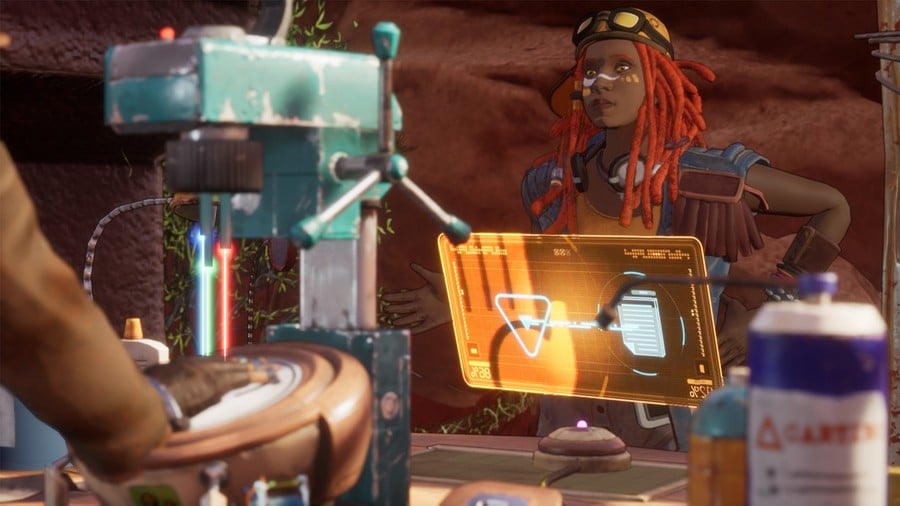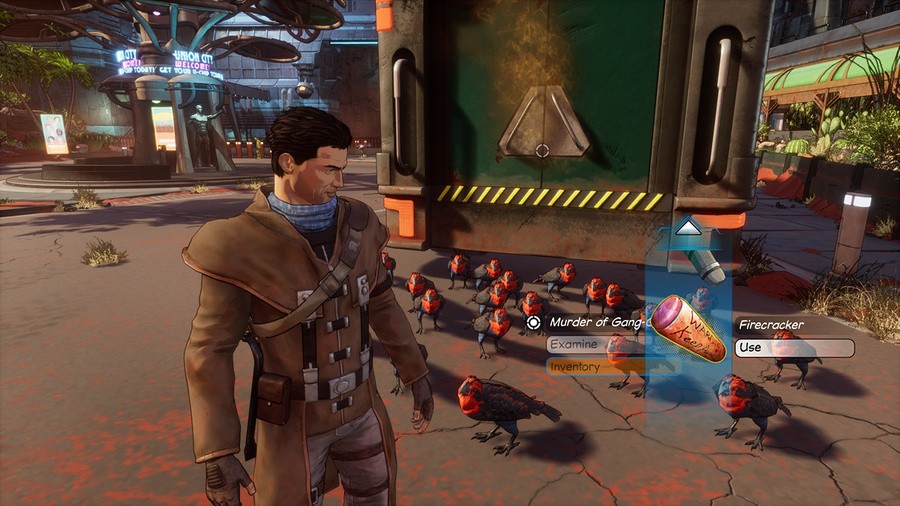
Charles Cecil needs no introduction to lovers of adventure games. The veteran designer co-founded Revolution Software in 1990 and produced a series of classic graphic adventure games including Lure of the Temptress and the Broken Sword series. His most recent project, Beyond a Steel Sky, released on Switch at the end of November and reunited Cecil with Watchmen co-creator Dave Gibbons on a long-awaited follow-up to Beneath a Steel Sky, the classic 2D adventure they released back in 1994 — the hey days of the classic point-and-click adventure game.
Recently we were fortunate enough to speak with Cecil via email to find out a little more about the project, what it was like returning to a world he created over a quarter of a century ago, and to see if he has plans for further adventures on Switch...
Subscribe to Nintendo Life on YouTube841k
What was it like creating a sequel to a game of yours so long after the original? We’ve read that you had story ideas from soon after the original – were those used?
The original game, Beneath a Steel Sky, was written in partnership with Dave Gibbons (comic book artist and co-creator of Watchmen). Dave and I had talked about a sequel on and off since, well, since the launch of the original game back in 1994. Indeed when I approached Dave with the slightly crazy plan to write a ‘spiritual successor’ (I tend not to call it a ‘sequel’ because so much time has passed) in about 2017, he sent me a story idea that he had written in 1995. It involved mechanical Pterodactyls across the Bass Strait — the water between Tasmania and mainland Australia.

The first thing that I did was to look back to identify why the original game has such enduring popularity and what fans would hope to see in a successor. This would include Foster’s relationship with Joey, and Union City almost as a character in its own right. Also, it always felt rather naive, maybe unfair to his friend, that Foster had left Joey in charge and just left: what happened to the city under Joey’s rule? I wanted to explore — and how would a benign AI seek to rebuild a city to make people happy.
This last question felt very relevant to the modern day — initiatives like China’s Social Credit system in which an AI rewards or punishes the micro-behaviours of citizens based on its own judgements. I was particularly interested by a report from the BBC in which some Chinese citizens praised the system saying that it stopped people spitting in trains!
The adventure community is so passionate about the genre. I feel thrilled and hugely privileged that, despite the long gap, the game has been so well received by both fans of the series as well as new players.
When you were putting together ideas for Beyond a Steel Sky, was there ever a point where you thought it might not be a 3D game?
The game was always imagined in 3D for several reasons.
I was always rather guilty that our original publisher, Virgin Interactive, claimed that Beneath a Steel Sky was an ‘interactive comic’ — which, except for the comic book that accompanied the game, couldn’t really have been much further from the truth. Now, utilising the Unreal Engine, we had the opportunity to deliver on this promise. We have written realtime post-processing tech that creates a visual look that complements Dave’s beautiful comic book style — and I remember how thrilled Dave was when he first saw the game running. Beyond the aesthetic, the art style also supports gameplay — when playing adventures, players study the backgrounds looking for clues, and the comic book style allows us to emphasise objects of relevance to enhance the gameplay experience.
I was always rather guilty that our original publisher, Virgin Interactive, claimed that Beneath a Steel Sky was an ‘interactive comic’
Revolution’s early titles were written around an engine called ‘Virtual Theatre’. Characters moved around the world, and responded to changes in the world instigated by player actions. At the time this was revolutionary. This played out, for example, in the original game in a puzzle that I was particularly proud of in which a factory owner, Gilbert Lamb (who proudly announces that his beaver skin coat was made of the last beavers in the world) uses an elevator to go down a level to his apartment. The player can hack into the computer systems, and remove his authority to travel — and sit and watch his frustration when the elevator refuses to transport him.
I had always regretted that we never took the Virtual Theatre concept further. This was, at least in part, because in fixed 2D locations, characters would disappear off screen and be invisible until they re-appeared — which could be very frustrating and feel rather haphazard. In full 3D, with the ability to move the camera, and display characters wherever they are in the game world, I felt that Virtual Theatre could be reborn — with puzzles based around the player being able to subvert the computer systems in the world, and how the characters react to those changes. The ability to subvert the world through a simple hacking system is central to the game — allowing puzzle solutions to emerge from how the game’s characters behave in response. This can lead to really fun situations — with the citizens sure that any outcome was intentional, however ludicrous.

Revisiting Union City after so long, how did you find it striking the balance between old and new, between nostalgia and taking the world in new directions?
Had this game appeared just a few years after Beneath a Steel Sky, then we could have assumed that almost everyone would have played the original. However, after over two decades, one of the prime objectives was to ensure that people who knew nothing about the original could play and enjoy the game without feeling disadvantaged. That did require us to weave considerable exposition into the backstory — but I think that the game feels richer for it, both for new players who see that there is an extensive lore which we respect and convey, and for fans of the original who get to see that same lore but told from a different perspective.
And for those who want nostalgia, we include a museum location — the Museum of Old History (next to the more popular Museum of New History) which has gathered together many of the most iconic objects that some players will remember from first time around.
What changes were involved in bringing the game to consoles, and specifically Switch?
The game debuted on Apple Arcade last year. It has been fantastic to be able to take fan feedback and continue to enhance the game (and, gulp, address bugs which we missed before the original release). We have added a commentary mode. We have added new functionality — my favourite is allowing the player to find and then choose to wear a large number of holo-brooches: graphics that are like memes in the gameworld.

Switch’s touchscreen and portability makes it an ideal home for adventure games – did you plan to bring it to the platform all along or did that decision come later?
Our plan was always to bring the game to Switch — it is, as you say, an ideal platform.
If you’re playing adventure games at home, what’s your ideal set-up? PC with a cup of something? Phone on the sofa?
I love my Switch. I have so little free time, and I really value whatever time I do get to play adventures — normally on the sofa or sitting up in bed. I am ashamed to admit that it’s often (usually) accompanied by a glass of wine.
Do you have any desire to bring Beneath or maybe other Broken Sword titles to consoles? Switch seems like a good fit for them.
Yes — and yes, Switch would, indeed, be a very good fit for them. [smiles]
While the adventure game genre has had its ups and downs, there have been some brilliant examples in recent years and a ‘resurgence’ of sorts. Why do you think that is, and what examples have you particularly enjoyed, on Switch or elsewhere?
The adventure, as a genre, has gone through an incredible resurgence since it was resurrected by the Nintendo DS just over a decade ago (it is funny to think that going into the new millennium, the publisher mantra was that the adventure was dead and the PC was no longer a viable gaming platform). Over the past few years, games like What Remains of Edith Finch, Return of the Obra Dinn, Her Story etc. have innovated the genre.
I would like to claim as kinda adventures two of my favourite games of the past few years — Untitled Goose Game with it’s wonderful chaotic gameplay, and Inside which manages to tell a profound, beautiful, story without a line of text or speech to explain. It is such a privilege to have been able to write adventure games for 40 years: 30 years at Revolution and text adventures for 10 years before that.

Finally, what are your plans this Christmas? And what projects do you have planned for 2022?
I am really looking forward to a few days off at Christmas. Of course it will be lovely to see the family and do Christmassy things. But I am also really looking forward to having the space to think hard about the ideas and concepts for our new adventure game which is in pre-production, to be announced at some point in the new year.
Many thanks to Charles for speaking with us. Beyond A Steel Sky is out now on Switch — read our review to find out more.





Comments 10
I'm mildly interested. But only to scoop up a standard physical copy after a deep discount. I saw that this has a $150 special edition and all I can think is, "but why". https://www.amazon.com/Beyond-Steel-Sky-Utopia-Nintendo-Switch/dp/B09JDS2YBT
@Magician I think 'Microids' being the publisher is why...
@GayusGayer Oh, those wonderfully outrageous French folk, eh? I respect them as a publisher more so than say 505 Games, Game Mill, Maximum Games, or Outright Games.
@Magician it seems Maximum games is publishing that one. I checked the link.
It’s a shame that Disney owns Lucas Arts. I would love to see a Monkey Island revival! I’d also love to see some of the old Sierra adventure games, somehow! Unfortunately, games like Willy Beamish will most likely remain in the past. There’s no demand for it.
I have this lined up after I finish the last 6 or 7 bosses in SMT5.
So including dying on the first attempt for each and powering up again, about another 20 hours?
But I can’t resist another Charles Cecil game.
Got this and it wouldn’t let me save the game, was 2 hours-ish in, played for half hour and wouldn’t let me save so lost that progress. I think it may be because I minimised the game and reopened, but not playing for now until hopefully a patch is released to fix this - I hate losing progress
@Gwynbleidd unfortunately not, got the steel book edition at £45
@noobish_hat
I can't speak for the second remaster, but the first took out all instances of being able to die. Huge disappointment
Play it folks, it’s a treat. Wasn’t expecting too much cause I didn’t know the original, and after an hour I realized: It’s exactly what I wanted. If you loved old point & click adventures but with a more cinematic feel, don’t skip this.
Show Comments
Leave A Comment
Hold on there, you need to login to post a comment...